Scrotal masses
Overview
Scrotal masses are lumps or swelling in the scrotum, the bag of skin that holds the testicles.
Scrotal masses might be:
- A buildup of fluids.
- The growth of irregular tissue.
- Swollen, inflamed or hardened parts inside the scrotum.
It's key to get a scrotal mass checked by a health care professional, even if you don't have pain or other symptoms. Some masses could be cancer. Or they could be caused by another medical condition that affects the health of the testicles and how well they work.
Each month, check your scrotum for any changes. Also get the area checked during regular health checkups. This can help you spot masses early, when many treatments work better.
Symptoms
Symptoms of scrotal masses vary. Some cause pain and others don't. It depends on the cause. Symptoms of a scrotal mass might include:
- An unusual lump.
- Sudden pain.
- Dull aching or a feeling of heaviness in the scrotum.
- Pain that spreads all over the groin, stomach area or lower back.
- A tender, swollen or hardened testicle or epididymis (ep-ih-DID-uh-miss). The epididymis is the soft, comma-shaped tube above and behind the testicle that stores and transports sperm.
- Swelling in the scrotum.
- A change in color of the skin of the scrotum.
- Upset stomach or vomiting.
If an infection causes a scrotal mass, symptoms also might include:
- Fever.
- Needing to pee often.
- Pus or blood in the urine.
When to see a doctor
Get emergency medical care if you have sudden pain in your scrotum. Some problems need to be treated right away to help prevent permanent damage to a testicle.
See a health care professional if you notice a lump in your scrotum or other unusual changes. Get a checkup even if you have a mass that isn't painful or tender.
Some scrotal masses are more common in children. See your child's pediatrician or other health care professional if:
- Your child has symptoms of a scrotal mass.
- You have any concerns about your child's genitals.
- A testicle is "missing." Sometimes, a testicle doesn't move down from the stomach area into the scrotum before birth. This is called an undescended testicle. It might raise the risk of some scrotal masses later in life.
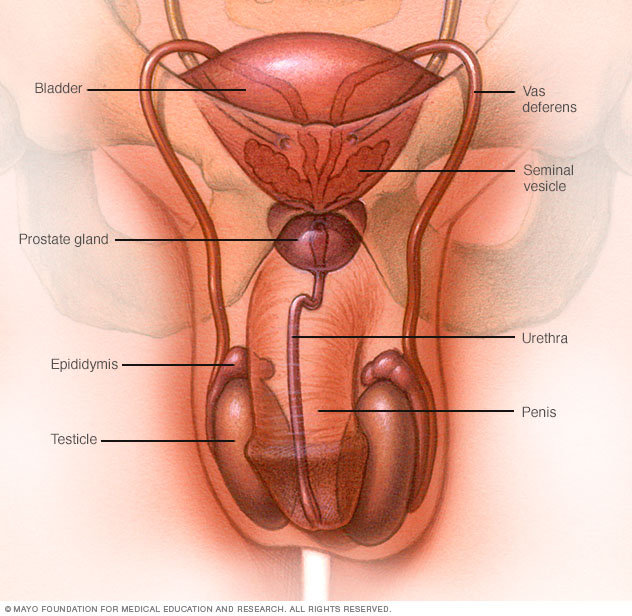
The male reproductive system makes, stores and moves sperm. The testicles produce sperm. Fluid from the seminal vesicles and prostate gland combines with sperm to make semen. The penis ejaculates semen during sexual intercourse.
Causes
Many health conditions can cause a scrotal mass or an unusual change in the scrotum. These include:
- Testicular cancer. This is cancer that starts in the testicles. It often causes a painless lump or swelling in the scrotum. But some people with testicular cancer don't have any symptoms. See your doctor or other health care professional if you notice a new lump in your scrotum.
- Spermatocele. This fluid-filled sac in the scrotum is often above the testicle. It tends to be painless. And usually, it's not cancer. A spermatocele also is known as a spermatic cyst or epididymal cyst.
-
Epididymitis. This is when the coiled tube at the back of the testicle, called the epididymis, becomes inflamed.
Often, epididymitis is caused by an infection with bacteria. For instance, bacterial infections that spread through sex, such as chlamydia, can cause it. Less often, a virus can lead to epididymitis.
- Orchitis. This is when inflammation, which can include pain and swelling, affects the testicle. Usually, it's due to an illness caused by a virus, most often mumps.
-
Hydrocele. This is when extra fluid collects between the layers of a sac that surrounds each testicle. Most often, there's a small amount of fluid in this space. But the excess fluid of a hydrocele can lead to a painless swelling of the scrotum.
In adults, a hydrocele can happen because of an imbalance in the amounts of fluid made or absorbed. Often, this is due to an injury or infection in the scrotum.
In babies, a hydrocele tends to happen because an opening between the stomach area and the scrotum hasn't properly closed during development.
- Hematocele. This is a buildup of blood between the layers of a sac that surrounds each testicle. An injury, such as a direct hit to the testicles, is the most likely cause.
- Varicocele. This happens when the veins inside the scrotum get bigger. Varicocele is more common on the left side of the scrotum due to differences in how blood flows from each side. A varicocele might cause infertility, which is when you can't get your partner pregnant after a year of unprotected sex.
-
Inguinal hernia. This is when part of the small intestine pushes through an opening or weak spot in the tissue that separates the stomach area and groin. It might appear as a mass in the scrotum or higher in the groin.
In infants, an inguinal hernia often happens before birth when the passageway from the stomach area to the scrotum doesn't close.
- Testicular torsion. This is a painful problem that cuts off blood to the testicle. It happens due to a twisting of the spermatic cord. That's a bundle of blood vessels, nerves and the tube that carries semen from the testicle to the penis. Without prompt treatment, testicular torsion can lead to the loss of the testicle.
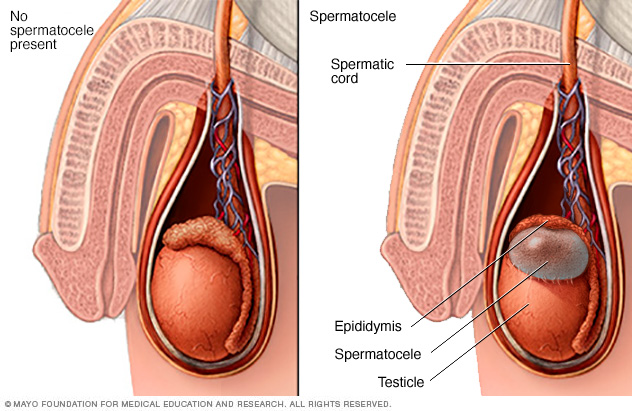
A spermatocele is a typically painless, noncancerous (benign), fluid-filled sac that grows near the top of a testicle.
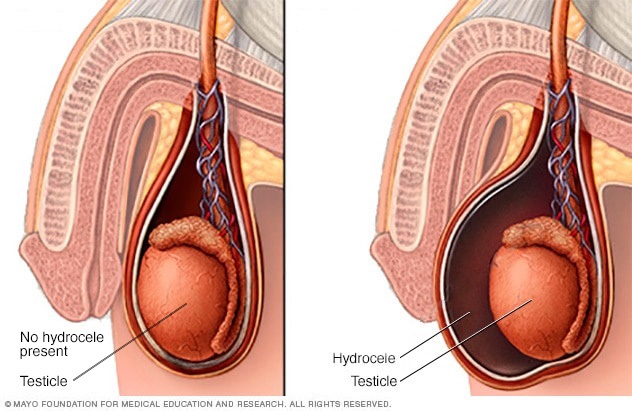
Hydrocele is the type of scrotal swelling that occurs when fluid collects in the thin sheath that surrounds the testicle.
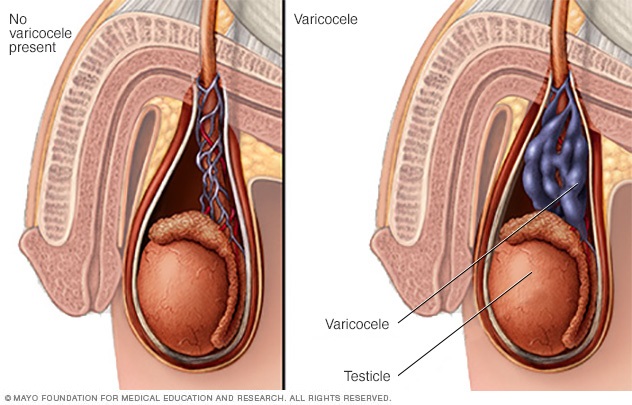
A varicocele is enlargement of the veins that transport oxygen-depleted blood away from the testicle.
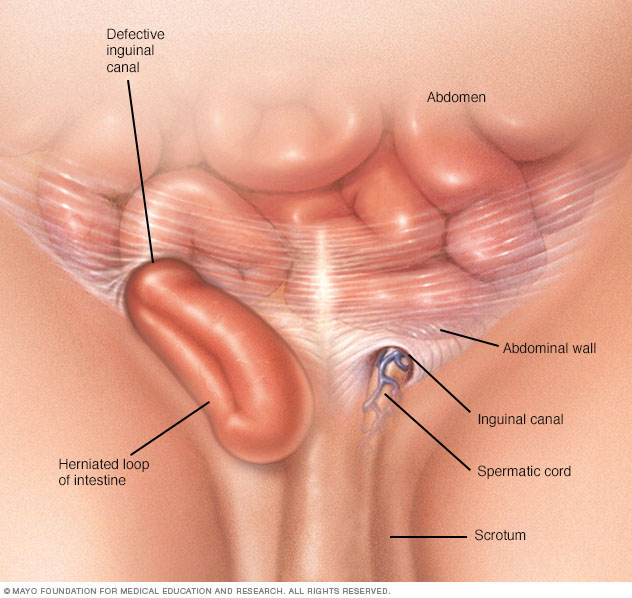
Inguinal hernias occur when part of the membrane lining the abdominal cavity (omentum) or intestine protrudes through a weak spot in the abdomen — often along the inguinal canal, which carries the spermatic cord in men.
Risk factors
Things that can raise the risk of a scrotal mass include:
- Undescended testicle. An undescended testicle doesn't leave the stomach area and move down into the scrotum before birth or in the months afterward.
- Conditions present at birth. Some people are born with irregular changes in the testicles, penis or kidneys. These might raise the risk of a scrotal mass and testicular cancer later in life.
- History of testicular cancer. If you've had cancer in one testicle, your risk of getting cancer in the other testicle is higher. Having a parent or a sibling who's had testicular cancer also raises your risk.
Complications
Not all scrotal masses lead to long-term medical conditions. But any mass that affects the health or function of the testicle can result in:
- Delayed or poor development during puberty.
- Infertility.
Diagnosis
To find out what kind of scrotal mass you have, you may need tests such as:
- A physical exam. During this exam, a doctor or other health care professional feels your scrotum, its contents and nearby areas of the groin while you stand and lie down.
- Transillumination. Shining a bright light through the scrotum might provide information about the size, location and makeup of a scrotal mass.
- Ultrasound. This test uses sound waves to make an image of the inside of the body. It can provide detailed information about the size, location and makeup of a scrotal mass. It also can show the condition of the testicles. An ultrasound often is needed to diagnose a scrotal mass.
- Urine test. Lab tests of a sample of urine might find an infection caused by a virus or bacteria. A urine test also might detect the presence of blood or pus in the urine.
- Blood test. Lab tests of a blood sample might find a bacterial or viral infection. Or they might detect higher levels of certain proteins that are linked with testicular cancer.
- Computerized tomography (CT) scan. If other tests show you have testicular cancer, you'll likely get this series of X-rays. A CT scan of your chest, stomach area and groin can check to see if cancer has spread to other tissues or organs.
Treatment
Treatment of a scrotal mass mainly depends on its cause.
Infections
Medicines called antibiotics can treat a scrotal mass caused by bacteria, as is often the case with epididymitis. If a virus causes epididymitis or orchitis, the usual treatment involves rest, ice and pain relief medicine.
Scrotal masses that aren't cancer
You might hear these called benign masses. Sometimes they don't need treatment. Other times, they need to be removed with surgery, repaired or drained. Treatment decisions depend on factors such as whether the scrotal mass:
- Causes discomfort or pain.
- Contributes to or raises the risk of infertility.
- Becomes infected.
Testicular cancer
If your scrotal mass is caused by cancer that starts in a testicle, you'll likely see a cancer doctor called an oncologist. The oncologist may recommend treatments based on whether the cancer is in the testicle or has spread to other body parts. Your age and overall health also are factors.
The main treatment choices include:
- Radical inguinal orchiectomy. This is the main treatment for testicular cancer. It's surgery to remove the affected testicle and the spermatic cord through a cut in the groin. Lymph nodes in your stomach area also might be removed if the cancer has spread to them.
- Chemotherapy. This uses powerful chemicals to kill cancer cells. Most often, you receive chemo through a needle in a vein. It's often used to cure testicular cancer that has spread beyond the testicle. It also is used to lower the chances of the cancer coming back after a testicle is removed with surgery. Chemo isn't a treatment for cancer that's only in the testicle.
Radiation therapy also may be used. It sends high-dose X-rays or other high-energy radiation to specific parts of the body. This can kill cancer cells or slow them from growing. With testicular cancer, the main use for radiation is to destroy cancer cells that have spread to the lymph nodes. Your provider may recommend this treatment after surgery to remove an affected testicle.
Most cases of early testicular cancer can be cured. And even if the disease spreads beyond the testicle, it still may be curable. But you'll need follow-up care to watch for signs that the cancer has come back.
Lifestyle and home remedies
Self-exams of the testicles might help you find a scrotal mass early on. To do a self-exam, follow these steps:
- Check your testicles once a month. This is key if you've had testicular cancer or if a blood relative, such as your father or brother, has had it.
- Do the exam after a warm bath or shower. The heat from the water relaxes your scrotum, making it easier for you to check.
- Stand in front of a mirror. Look for swelling on the skin of the scrotum.
- Cup your scrotum with one hand to see if it feels different than usual.
- Check one testicle at a time using both hands. Place the index and middle fingers under the testicle; place your thumbs on top.
- Gently roll the testicle between the thumbs and fingers to feel for lumps. The testicles are usually smooth, oval shaped and somewhat firm. Often, one testicle is slightly larger than the other.
- Feel along the soft, comma-shaped structure that runs above and behind the testicle, called the epididymis, to check for swelling.
If you find a lump or other unusual change, seek medical care to get it checked as soon as you can.
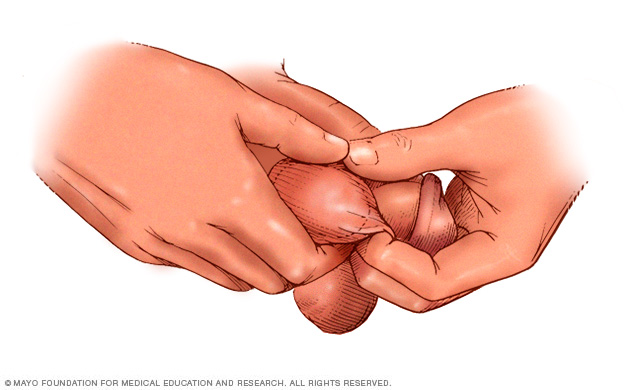
To perform a testicular self-exam, grasp and roll the testicle between your thumbs and forefingers, feeling for lumps, swelling, hardness or other changes.
Preparing for an appointment
Get emergency care if you have pain in your scrotum or testicles. If you find a scrotal mass, you'll probably start by seeing your doctor or other health care professional. You might be referred to a doctor called a urologist, who treats urinary tract and male genital conditions.
Preparing for the appointment helps you make the most of your time during the visit.
What you can do
Write down information to share with your care team, such as:
- Your symptoms, including any that may seem unrelated to a scrotal mass.
- Key personal information, including major stresses or recent life changes.
- Medicines, vitamins and supplements you take.
- Family history of testicular cancer or other health problems with the scrotum.
- Personal medical history, including previous scrotal masses, undescended testicle or genital conditions you were born with.
- Questions to ask your care team.
Questions you could ask about scrotal masses include:
- What tests will I need?
- How long will it take to get the test results?
- If the scrotal mass is cancerous, what are the next steps?
- If the scrotal mass isn't cancerous, will I need treatment?
- Are there brochures or other printed material that I can take with me? What websites do you recommend?
Don't hesitate to ask any other questions.
What to expect from your doctor
Be prepared to answer many questions, including:
- When did you find a lump or notice other symptoms linked with a scrotal mass?
- Do you have pain in or near your scrotum?
- Have you had a fever or seen blood or pus in your urine?
- Have you had a recent injury to the groin?
- Does anything, such as pain medicine, make your symptoms better? Does anything make your symptoms worse, such as exercise or activities that put a strain on the groin?
- Did you have an undescended testicle that was corrected with surgery?
- Have you ever had a sexually transmitted infection? Do you have more than one sex partner or a new sex partner?
Last Updated Aug 4, 2023
© 2024 Mayo Foundation for Medical Education and Research (MFMER). All rights reserved. Terms of Use